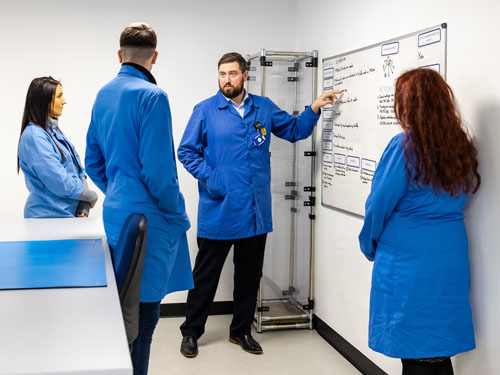For the medical battery manufacturing industry, this standard ensures that products are consistently designed, produced and delivered to meet both customer and regulatory requirements.
As a global battery pack manufacturer, Alexander Battery Technologies (ABT) aligns its operations with ISO 13485 to cater to the stringent demands of the medical sector, which is crucial in terms of maintaining the highest levels of safety and efficiency.
Classifications and applicability
ISO 13485 compliance is particularly critical for manufacturers dealing with medical devices in various classifications. The standard applies to four classes of devices:
- Class 1: low risk devices such as plasters, bandages, wheelchairs and crutches
- Class 2A: medium-risk devices such as blood pressure monitors, baby scan monitors and stethoscopes
- Class 2B: higher risk devices including contact lenses and X-ray machines
- Class 3: high-risk devices such as joint replacements and pacemakers.
Our focus is primarily on Class 2A, 2B, and 3 devices. This emphasis on higher-risk categories necessitates the implementation of robust quality management systems to ensure that our battery packs and OEM chargers meet the precise needs of our clients throughout the medical industry.
Impact on medical industry operations and compliance
For medical device manufacturers, ISO 13485 is not just a regulatory requirement. It is a framework that guarantees product safety and effectiveness. This standard affects various aspects of operations including machinery, process controls and documentation practices.
By adhering to ISO 13485, organisations can ensure that their products are designed and manufactured consistently to meet customer and regulatory expectations.
We utilise customer specifications as the foundation for our battery pack designs. This customer-centric approach ensures that our products are not only compliant with regulatory standards but also meet the specific performance requirements of our clients.
For instance, when developing a battery pack for an infusion pump or a bone saw, we meticulously follow the customer’s specifications to design a product that is robust and reliable, thus ensuring patient safety and device effectiveness.
Challenges of implementing ISO 13485
Adopting ISO 13485 poses several challenges, particularly when establishing and maintaining robust procedures and comprehensive documentation. One significant challenge is ensuring that all documentation outputs align with the standard.
For example, manufacturers of medical devices must demonstrate adherence to stringent cleanliness and cross-contamination protocols, which requires presenting valid data during audits to prove that these procedures are followed correctly.
For ABT, this means implementing stringent controls throughout our manufacturing process. We need to ensure that each step, from initial design to final production, meets the rigorous requirements of ISO 13485.

This includes validating all manufacturing steps, performing thorough tests at various stages and maintaining detailed records of all activities. This level of diligence is crucial to achieve compliance and maintain the trust of our clients and regulatory bodies.
Real-world application
To illustrate the practical implications of ISO 13485, consider the development of a battery pack for a Class 2A device, such as a blood pressure monitor.
The process begins with receiving and understanding the customer’s specifications, which detail the required power output, voltage and other critical parameters.
Based on these specifications, our design team creates a prototype that fits within the device’s spatial constraints and meets its power requirements.
Once the design is finalised, we move to the manufacturing phase; here, each component undergoes rigorous testing. For instance, our battery packs are subjected to various welding processes (resistance, laser and TIG) to ensure strong and reliable connections.
We also conduct drop tests to assess the durability of the battery packs in real-world conditions.
Throughout the manufacturing process, we maintain full traceability of each component — from raw materials to finished products. This traceability is crucial for addressing any issues that may arise and to ensure that each battery pack meets both our internal standards and those of ISO 13485.
ISO 13485: a pillar of quality and innovation in medical battery manufacturing
In conclusion, ISO 13485 is an indispensable standard within the medical battery manufacturing industry, providing a comprehensive framework for quality management that ensures the highest levels of safety and efficacy.
Its adoption is not only crucial for regulatory compliance but also to develop trust among healthcare providers and patients.
The implementation of ISO 13485 requires manufacturers to maintain stringent controls and robust documentation processes, addressing challenges such as cleanliness, cross-contamination prevention and full traceability of products.
These stringent requirements necessitate continuous improvement and vigilance in quality management practices, ultimately leading to superior product reliability and performance.
For the medical industry, the benefits of adhering to ISO 13485 are multiple. Enhanced product quality and consistency contribute to better patient outcomes and increased confidence in medical devices.
The standard also drives operational efficiencies and reduces the risk of product recalls or failures, thereby protecting the reputation manufacturers and minimising financial liabilities.
ISO 13485 also facilitates innovation in medical technology. By setting clear guidelines for quality management, it allows manufacturers to focus on developing advanced solutions that meet the changing needs of the healthcare sector.
This, in turn, supports the growth and advancement of the medical industry as a whole, enabling the delivery of cutting-edge medical devices that improve patient care and outcomes.
At ABT, our adherence to ISO 13485 demonstrates our commitment to quality and reliability. By aligning our processes with this standard, we ensure that our battery solutions not only comply with regulatory requirements but also meet the highest expectations of our clients in the medical sector.
This dedication to maintaining rigorous quality standards helps us to deliver innovative and dependable products that support the critical work of healthcare professionals.
In an industry in which precision, reliability and safety are paramount, ISO 13485 serves as a cornerstone to ensure that medical devices meet the rigorous demands of both regulatory bodies and end-users.
The commitment to this standard highlights the industry’s commitment to maintaining the highest quality standards, thereby safeguarding public health and enhancing the effectiveness of medical treatments worldwide.
